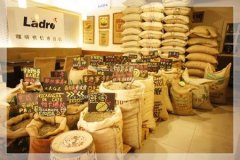The History of Coffee Culture in Japan
Coffee was first introduced to Japan during the Genroku period in Nagasaki. And people officially accepted it from the Meiji era. Let's take a look at the history of coffee in Japan!

At first, the Japanese were not used to the aroma of coffee houses in Western Europe. At the time when coffee culture literature and art were in full bloom, Japan was in the midst of the strict policy of isolation in the Edo period. Coffee, the first drink of its time, was established at the Dutch Chamber of Commerce in Dejima, Nagasaki (1641), presumably brought in at that time. However, those who can come into contact with foreigners are servants (officials), businessmen, interpreters and tourists. In 1776, two or three translations of "Zumberu's Journey to Japan" finally knew the delicacy of coffee. Coffee, a symbol of foreign culture that was specially transmitted to the island, could not be popularized at that time. "
The Japanese drank coffee in 1804. In the book "Qiongpu Youzui," the Shushan people in Daejeon were invited to drink something called "coffee." Beans were fried black and powdery. After mixing with white sugar, they drank it. The smell and bitterness of burnt bitterness could not be adapted. From the background that coffee is imported from the island and is not widely accepted, the policy of isolation does affect the Japanese people's unaccustomed taste of new drinks.
In 1823, he went to the Dutch residence in Dejima, Japan, and seemed to like coffee. It is recorded in the book "Edo Sanfu Notes" that "Japanese people like to drink coffee when they get along with us."
The real popularity began in the middle of Meiji. Members of the magazine "Aki" Kitahara Shiraaki, Ishikawa Takaki, Takamura Kotaro, Sato Haruo, Nagai Karikaze, etc. use the "Hongno Nest" site in Nihonbashi Onet Town as their monthly meeting place. In that shop you can drink authentic French cuisine and wine, coffee is authentic French style deep roast coffee. Hong's nest is like a social arena for literati.
From the Meiji era to the Taisho era, cultural salons like this did help create several coffee houses, and Japan finally entered the coffee culture. However, it was still a rare shop for ordinary people.
Coffee salons formed at that time were social places for literati or literary youth, but at the same time, cheap coffee houses were unconsciously popular. At the height of the Taisho era, there were more than 20 branches nationwide. Why are coffee salons so popular? Because in the high-end Western restaurant coffee, then a cup of 15 money, and imitation of Paris or New York coffee shop, then thoroughly implement a cup of 5 money of low-priced coffee. So for a third of the price, you can have authentic and aromatic Brazilian coffee. At the famous coffee salons in the country, the number of Japanese who taste delicious coffee is countless. Coffee salons leave an indelible legacy for popular coffee.
Coffee lovers did increase a lot during the Taisho era, and they became more popular during the Zhaohe era. However, during World War II, coffee was stopped because it was an "enemy drink." Coffee disappeared from Japanese life for a while. Coffee is appreciated and loved as a "messenger of peace."
The coffee market in Japan is very competitive. Includes tea shop and home regular coffee and instant coffee, home coffee and office coffee, a variety of canned coffee, plus hospitality coffee, delicious coffee and so on. Especially in the Heisei era, the demand for more authentic coffee increased.
Important Notice :
前街咖啡 FrontStreet Coffee has moved to new addredd:
FrontStreet Coffee Address: 315,Donghua East Road,GuangZhou
Tel:020 38364473
- Prev

General knowledge of boutique coffee culture Viennese coffee culture
Coffee is something that Viennese enjoy talking about and are quite proud of. The Viennese even compare it with music and waltz, which is called the three treasures of Vienna, which shows the relationship between Viennese and coffee. Some people say that Vienna is a five-step coffee, which may be an exaggeration by the poet, but it is true that there are a large number of Vienna cafes. Coffee kiosks for people to drink standing up from street corners,
- Next

The influence of High-quality Coffee Culture and Environment
Coffee is not only one of the most popular drinks in the world, but also one of the most traded products in the world. I've been writing a book about coffee recently, but I've been hesitant: I don't know how many coffee consumers really want to know about the things behind coffee. Many of us like to savor the taste and feeling of a cup of hot Scotch coffee, not to mention the taste.
Related
- How did the Salvadoran coffee industry develop in Central America?
- What exactly does the golden cup extraction of coffee mean?
- The Origin of Coffee flower
- [2023 Starbucks World Earth Day] there are more meaningful things besides free Starbucks coffee!
- What kind of coffee is there in Spain? 9 Flavors of Spanish Coffee
- Aromatic African coffee| Kenya's coffee culture and historical production area
- Liberica Coffee Bean knowledge: the characteristics of Liberian Coffee beans of the three original species of Coffee beans
- The origin and formula of Spanish latte introduces the taste characteristics of Bombon coffee in Valencia, Spain.
- How to adjust the solution of over-extracted coffee
- What is the tasting period of coffee beans? What is the period of coffee and beans? How should coffee wake up and raise beans?

